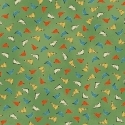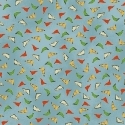Shelburne Circus
The coming of the circus was an annual event awaited with great anticipation in 19th and early 20th century America. Weeks before the circus was due, colorful posters appeared on barns and fences, announcing the dates and new performers. Finally the circus arrived! Excitement grew as wagons, elephants and clowns paraded through town and the big-top tent was raised.
Traveling circuses are represented at Shelburne Museum by the vintage advertising posters that line the inside wall of the 545-foot long, horseshoe shaped concourse of the Circus Building. The Museum's collection of posters from the Golden Age of the American traveling circus (1870-1950) number over five hundred and is among the finest and most comprehensive in the country, including posters that survive nowhere else. The posters are typically brightly colored and attention-getting with eye-popping graphics featuring dramatic new acts, exotic animals and sensational and outrageous (and sometimes utterly false) claims - the largest, the smallest, the most dangerous, the rarest, the one and only, etc. - all designed to sell tickets.
Two elaborately carved miniature circuses are also on exhibit at Shelburne Museum. The Circus Parade, which is over five hundred feet long and runs the length of the Circus Building, was begun in 1925 by Roy Arnold of Hardwick, Vermont. Built on a one-inch to one-foot scale and inspired by memories of his childhood, Roy Arnold, along with four other skilled woodcarvers, spent 25 years painstakingly replicating, in miniature, the most ornate parade vehicles from detailed drawings and old photographs. Arnold's attention to detail was extended to each wagon's fully functioning brakes and sunburst wheels, which were made of more than sixty individual pieces. The miniature parade is complemented by pony-sized wagons and several life-sized figures originally carved by Samuel Robb in the 1890's for Barnum and Bailey's tableau wagons.
The Kirk Bros. Circus is a highlight of Shelburne Museum's circus collection. Edgar Decker Kirk, a brakeman for the Pennsylvania Railroad, made the complete three-ring circus over a period of almost fifty years completely from memory using no photographs. Mr. Kirk carved and painted the 35,000 piece miniature circus from 1910 until his death in 1956. Working at night after twelve-hour days with the railroad, Mr. Kirk used scrap lumber and a treadle-operated jigsaw to cut the figures for his circus, then completed carving them with an ordinary pocketknife. The Kirk Bros. Circus, complete with animal acts, clowns, trapeze artists, bands, side shows and bleachers full of spectators and vendors is considered a masterpiece of American folk art.
The Circus Building also features forty carousel figures made by the Gustav Dentzel Carousel Company of Philadelphia from about 1895 to 1902. Dentzel 's carousel figures set the standard for quality with exquisite painting and the finest craftsmanship in the field.
Windham Fabrics has used motifs from all of these collections to inspire this unique circus collection for quilting. For more information about Shelburne Museum and their upcoming special circus exhibit, Circus Day in America on exhibit from May 16 through October 24, 2010, please visit shelburnemuseum.org.
Cotton
Free Projects





















